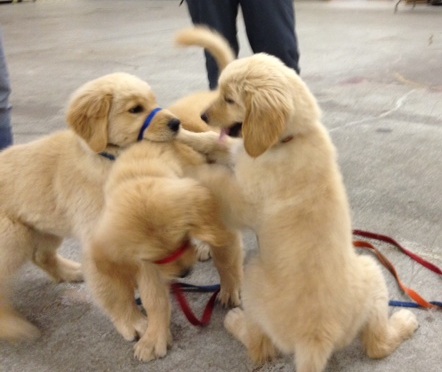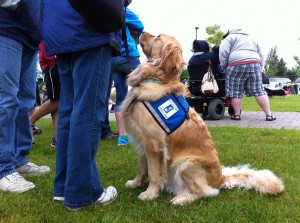I did sign a contract with Helping Paws, but that’s not the contract that I’ve been thinking about. There’s this other, more important contract. I have established a social contract with Seva. It has strict guidelines and is renewed moment-to-moment through my consistent behavior.
We all have social contracts with our pets, to one extent or another. I had an extensive social contract with Turtle, my cat—extensive on my part. Her end of the deal consisted of “love me back and look cute,” two things that came naturally to her. My contract with Seva is extensive on both ends. This dog earns everything from food to praise to basic attention.
Clause One: Click and Treat.
The foundation of this contract is that if I click, Seva gets a treat, even if it is an accidental click. She has been conditioned to that click, and my job is to consistently reinforce the association. Every time she does what I ask, she is rewarded. Every time she is rewarded, her good behavior is reinforced.
Right now, she is learning Loose Leash Walking (say that a few times fast!). Whenever she follows me without pulling on the leash, I click and treat. If she pulls, I stop moving and wait. I hold the leash and wait patiently for her to refocus. Once she notices me again, I click and treat. I move, she follows, click, treat, ad nauseam. This is all with me walking backwards, encouraging her forward. Today we upped the stakes. Now, I turn around and walk forward. She is expected to walk beside me, instead of following me, and that is a lot harder.
Some people get their dogs to walk on a leash by keeping a tight grip on a short leash, and when the dog pulls they don’t let him stray. Still, the dog pulls, and the dog gets accustomed to the collar pressed against his throat. The dog learns this is how he walks.
Seva is learning how to walk by being rewarded for doing it right and ignored when she does it wrong. If you’ve seen a service dog in public, then you know how effective this training is. Those dogs walk nicely beside their humans without pulling or straying, without getting their paws stepped on or rolled over, without losing focus whenever a person or new smell crosses their paths. The goal is for the dog to keep pace with her human with as little control as possible. Imagine how long it would take to get through Target if you had to constantly remind a dog where to be and when to move and to pay attention.
While I ask a lot of Seva, and it is constant, I make certain that what I ask is only what she can reasonably accomplish. Let me say, while I am training Seva, our Helping Paws Trainer, Sue, is training me. Seva’s education is my education, also.
Clause Two: I never tease Seva. Ever.
Suppose Seva is sitting in front of the freezer, giving me those eyes. I do not pull out an ice cube and hand it to her, no matter how cute she is. She has to work for her ice cube.
I pull out the ice cube and she starts doing circles as her excitement grows. She might jump, and I withdraw the cube and turn away from her. I say, “Wait,” and she sits again, though now she’s growing twitchy with anticipation. Only when she has taken that breath that signals she is resigned to waiting patiently do I give her the ice cube. And this week, I raised my expectations.
Instead of tossing the cube on the floor, I lower my hand, reminding her to wait for it. If she stays sitting, I keep lowering my hand. When my hand is in front of her, I say, “Easy” as I open my hand to reveal the treat. I am risking a nip as she lunges at her treat, but she’s a smart pup. She is both eager and careful. So far she hasn’t gotten me and each time I do this, she is a little slower, a little gentler.
It may seem like a lot of work just to deliver an ice cube, for both of us, but it’s part of the program. She knows absolutely that she will get that ice cube. Even if she fails to perform how I want, she will get the cube. The secret to success is making my expectations equal to her ability. I did not start feeding her treats off my hand until I was confident she would take them without biting off a finger. We’ve been working with the cue “Easy” for a couple of weeks. It was not entirely new, but using it with a treat that makes her spin in circles was new.
Clause Three: Seva is never punished.
This method of training is one of rewards only. There is no scolding or punishing. If she misbehaves, she is ignored or redirected to an appropriate behavior. If her behavior is dangerous or destructive, we immediately take control of the situation, but that is not the same as punishing her.
Seva has earned a few different nicknames: Berserker, Bity McBite Bite, and most recently Dingo. If we are dealing with any of these dogs instead of our sweet little Seva-Bear, she can be crated for a time out. I do not, however, shove her into the crate and slam it shut, no matter how frustrated I am with the Dingo that has been gnawing on my arm. I get her attention with a treat and toss it in the crate so she goes in herself, or—now that we’ve been working on the cue—I show her the clicker, say, “Kennel” and wait for her to go in. Once she is in the crate, I click and treat, then shut the door for her time out. This way, the time out is practically her own idea.

After class, playing with her brother and sister.
Because I abide by this social contract, and my family also follows the rules, Seva’s world is secure and predictable, which makes it easy for her to learn and to please. She is becoming a dog that is confident, gentle, and reliable.










